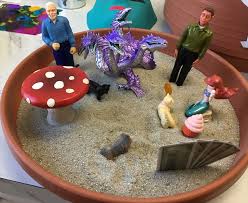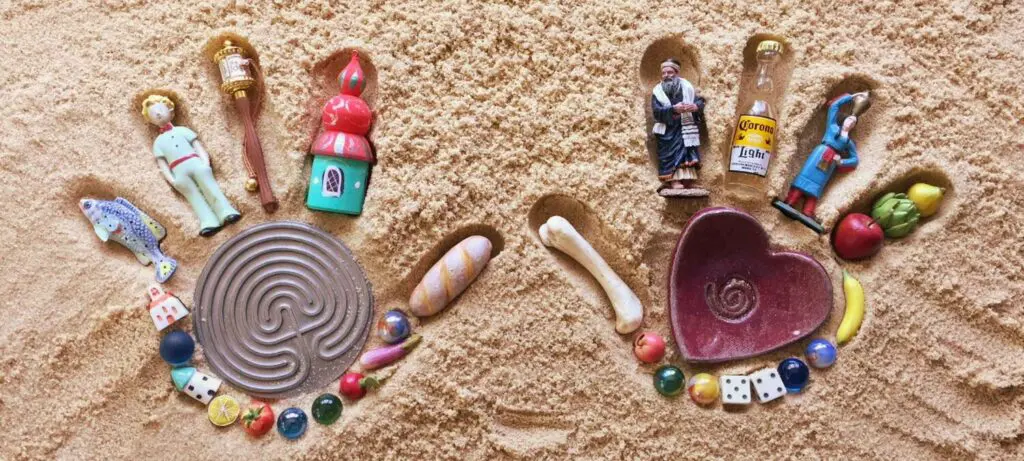Sand tray sand play therapy is a therapeutic practice that uses sand to help people work through their challenges. The benefits of the sand tray and play therapy are vast. It has been used for decades to address mental health issues in children, adults, and families. Sand tray therapists use the tactile nature of the medium to provide a calming environment for reflection and problem-solving. In this article, we will explore what this type of therapy is all about!
Contents
- 1 What Is Sand Tray Sand Play Therapy?
- 1.1 History And Development
- 1.2 Do Sand Tray Sand Play Therapy Differ?
- 1.3 Sand Tray Sand Play Therapy Techniques
- 1.4 Sand Tray Sand Play Therapy For Children
- 1.5 Sand Tray Sand Play Therapy For Adults
- 1.6 Sand Tray Sand Play Therapy for Groups
- 1.7 Sand Tray Sand Play Therapy For Trauma, Neglect or Abuse
- 1.8 Limitations of Sand Tray Sand Play Therapy
- 2 Professionals View On Sand Tray Sand Play Therapy
- 3 Conclusion
What Is Sand Tray Sand Play Therapy?

Sand tray sand play therapy is a therapeutic practice that uses small plastic or wooden trays filled with sand to help people work through their challenges. The therapist and client use the tactile nature of the medium to provide a calming environment for reflection and problem-solving. The sandbox provides a limitless space in which clients can create scenes, characters, and environments that are personalized for their unique situations.
History And Development
The history of sand tray therapy stretches back to the late 1800s, when French pediatrician, Désiré-Magloire Bourneville first used a sandbox. It was tried as a part of his work with children who had mental disabilities. He believed that the sandbox provided a limitless space in which children could create scenes, characters, and environments that were personalized for their unique situations.
In the early 1900s, German psychologist Karl Bühler used sand tray therapy with adults who had experienced trauma. He found that it was an effective way to help them process their experiences and work through their challenges.
Do Sand Tray Sand Play Therapy Differ?

The terms sand play therapy and sand tray therapy are often used interchangeably, but there is a subtle difference between the two.
- Sand play therapy refers to the use of objects in a sandbox to create scenes,
- While sand tray therapy refers to the use of a sandbox itself
The practitioner may choose to incorporate various objects into a sand tray therapy session. But for many people, it’s simply about finding peace and solace in the smooth lines of the sand as they shape them with their hands.
Sand Tray Sand Play Therapy Techniques

There are several techniques that sand tray therapists use to help their clients process and work through issues.
Editing Scenes
Clients may choose to create a specific scene, such as their dream home or the perfect day at the beach. The sand tray therapist can then ask them questions about that particular scene. And this is how they guide them toward self-discovery and problem-solving. It can also help them to explore and understand their feelings in a safe and non-threatening environment.
Role-Playing
Role-playing with sand tray therapy can be helpful for clients who are struggling with issues such as social anxiety or shyness. They can use the sandbox to create scenes in which they take on different roles. Thus giving them practice in new situations and allowing them to practice new behaviors.
Therapist-Created Scenes
The sand tray therapist can also create scenes for clients, such as a party or family reunion. This may help the client open up about their feelings and connect with others in positive ways that they might not have been able to do otherwise.
Sand Tray Sand Play Therapy For Children
One of the most common applications of sand tray therapy is with children who have mental health challenges or behavioral issues. The sandbox provides a safe and non-threatening environment in which children can express their feelings.
They may choose to create scenes that illustrate how they feel, or what has happened to them. Therapists who work with children often bring toys into the sandbox. So that they have a wide variety of objects at their disposal as they play through different situations.
Some therapists even invite parents to participate in the sand play therapy session with their children. This can be a powerful way for the family to work together and understand each other better.
Sand Tray Sand Play Therapy For Adults
Although sand tray therapy is most commonly a go-to option for children, it can be equally helpful for adults who are struggling with mental health challenges like depression or anxiety.
People of all ages can benefit from this type of therapeutic practice because it allows them to express themselves in a way that feels safe and non-threatening.
In Short
Sand tray sand play therapy is a powerful way to help children and adults work through issues such as:
- Grief and loss
- Loss of self-esteem due to mental health, physical disability, or developmental challenges.
- Anger management and impulse control problems
The smooth lines of the sandbox can be a calming counterpoint to the busy world around us.
Sand Tray Sand Play Therapy for Groups
Although sand tray therapy is often used as a one-on-one therapeutic practice, it can also be adapted for use in group settings.
This can be especially helpful for children who are struggling with social anxiety or peer pressure. They can use the sandbox to interact with other children in a safe and supportive environment.
The therapist can also use sand tray therapy with groups of adults to encourage them to interact positively. In this case, the sandbox provides an opportunity for people from all walks of life and different backgrounds to connect on common ground.
Sand Tray Sand Play Therapy For Trauma, Neglect or Abuse
Many sand tray therapists work with their clients to help them process past trauma and neglect by creating scenes in which they can face difficult situations. Clients may choose to create images of people who have hurt them, places where the abuse took place, or objects that are associated with the trauma. This can be a very effective way for them to start to process and understand what has happened to them.
Limitations of Sand Tray Sand Play Therapy
While sand tray therapy is an effective tool, it does have some limitations. It may not be appropriate for clients who are resistant to change or those who are struggling with severe mental health issues. Sand Tray Sand Play Therapy also requires that the client have a certain degree of fine motor skills. However, it may be difficult for people who are suffering from brain injuries or developmental challenges.
For sand tray therapy sessions to be successful, a trained therapist must conduct these sessions who understands how to create a safe and non-threatening environment. The therapist must also be able to provide appropriate guidance as the client works through their issues in the sandbox.
However, there are some situations where sand tray therapy cannot be a good option. For example, this type of practice should never replace other therapeutic practices that have been prescribed by doctors or mental health professionals. It has its limitations for clients who are dealing with severe mental health challenges or those who may be a threat to themselves or others.
Professionals View On Sand Tray Sand Play Therapy

People who practice sand tray therapy as part of their profession have a variety of opinions about its effectiveness.
- Some therapists feel that the sandbox creates an entirely safe and supportive environment, allowing clients to express themselves freely without judgment or criticism.
- Other professionals believe that the therapist should play a more active role in helping the client, using the sandbox as a springboard for further talk therapy.
Therapists must remain aware of their client’s feelings and reactions to give them support. Also, there must always be limits set so that no one person dominates the sandbox.
It is through the careful and sensitive use of sand tray therapy that we can help our clients find a resolution for their past difficulties and move forward into a brighter future.
Conclusion
Sandbox can be a great way for children and adults to process difficult emotions and experiences. It provides a safe and supportive environment in which they can explore their feelings without fear of judgment or criticism.
Therapists who use sand tray therapy should remain aware of their clients’ reactions so that they can offer support when needed. The careful use of this type of sand play therapy helps people resolve past issues and move forward into a brighter future.
If you are looking for affordable Online Counseling MantraCare can help: Book a trial therapy session


